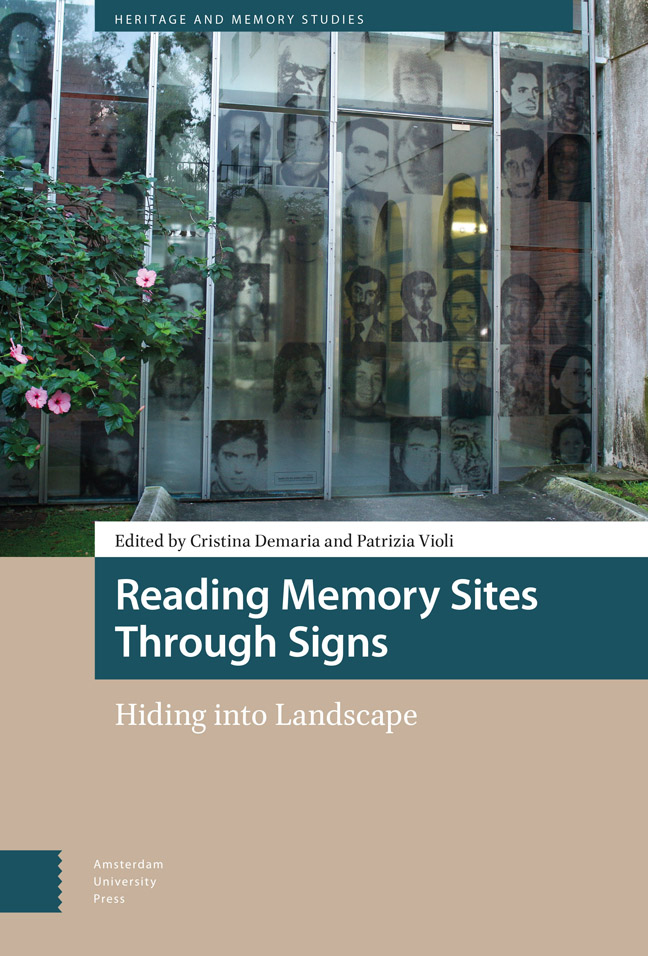Book contents
- Frontmatter
- Contents
- List of Illustrations
- For a Semiotics of Spaces of Memories: Practices of Enunciation and Narratives from Monuments to Global Landscapes of Inheritance
- 1 Stories that Shape Spatialities: Lieu and Milieu de Mémoire through the Lens of Narrativity
- 2 Interpretation and Use of Memory: How Practices Can Change the Meanings of Monuments
- 3 Uncomfortable Memories of Fascist Italy: The Case of Bigio of Brescia
- 4 What Does Fascist Architecture Still Have to Tell Us?: Preservation of Contested Heritage as a Strategy of Re-Enunciation and ‘Voice Remodulation’
- 5 Berlin, the Jewish Museum and the Holocaust Memorial
- 6 Making Space for Memory: Collective Enunciation in the Provincial Memory Archive of Córdoba, Argentina
- 7 Ruins of War: The Green Sea and the Mysterious Island
- 8 Turning Spaces of Memory into Memoryscapes: Cinema as Counter-Monument in Jonathan Perel's El Predio and Tabula Rasa
- 9 Voices from the Past: Memories in a Digital Space: The Case of AppRecuerdos in Santiago, Chile
- 10 500,000 Dirhams in Scandinavia, from Mobile Silver to Land Rent: A Semiotic Analysis
- Index
- Index of Names
1 - Stories that Shape Spatialities: Lieu and Milieu de Mémoire through the Lens of Narrativity
Published online by Cambridge University Press: 17 February 2024
- Frontmatter
- Contents
- List of Illustrations
- For a Semiotics of Spaces of Memories: Practices of Enunciation and Narratives from Monuments to Global Landscapes of Inheritance
- 1 Stories that Shape Spatialities: Lieu and Milieu de Mémoire through the Lens of Narrativity
- 2 Interpretation and Use of Memory: How Practices Can Change the Meanings of Monuments
- 3 Uncomfortable Memories of Fascist Italy: The Case of Bigio of Brescia
- 4 What Does Fascist Architecture Still Have to Tell Us?: Preservation of Contested Heritage as a Strategy of Re-Enunciation and ‘Voice Remodulation’
- 5 Berlin, the Jewish Museum and the Holocaust Memorial
- 6 Making Space for Memory: Collective Enunciation in the Provincial Memory Archive of Córdoba, Argentina
- 7 Ruins of War: The Green Sea and the Mysterious Island
- 8 Turning Spaces of Memory into Memoryscapes: Cinema as Counter-Monument in Jonathan Perel's El Predio and Tabula Rasa
- 9 Voices from the Past: Memories in a Digital Space: The Case of AppRecuerdos in Santiago, Chile
- 10 500,000 Dirhams in Scandinavia, from Mobile Silver to Land Rent: A Semiotic Analysis
- Index
- Index of Names
Summary
Abstract
This chapter offers an examination of the nexus between space and memory by exploring the concepts of lieu and milieu de mémoire. My aim is to show how, in memory-making processes, these two semiotic configurations are not mutually exclusive, as Pierre Nora argues, but mutually articulated. In the first part of the chapter, I will discuss Nora's definitions, comparing them to Michel de Certeau's articulation of lieu and espace and through the lens of Algirdas J. Greimas's model of narrativity. In the second part, I will translate theoretical and methodological reflections into a practical analysis, specifically through an exploration of the case of the Italian concentration camp of Fossoli.
Keywords: Place of Memory; Fossoli; Algirdas Julien Greimas; Pierre Nora; Michel de Certeau.
Ever since the publication of Pierre Nora's monumental collection (Nora 1996 [1984]), the category of lieu de mémoire – translated as ‘place’ or ‘site’ of memory – has offered one of the main conceptual prisms through which to analyse the space–memory nexus. In the introduction to the collection, Nora explains that ‘collective memory was rooted, in order to create a vast topology of French symbolism’, and that the aim of his work is to analyse how ‘the collective heritage of France was crystallised in places of memory’ (Nora 1996 [1984]: xv). According to the historian, the category of lieu de mémoire describes the way memory assumes and reaches a cultural and collective dimension in our times. Despite the focus on France, the category of lieu de mémoire has been used to interpret the meaning of tangible and intangible heritage in other, sometimes very different, national contexts (for Italy see, for example, Isnenghi 1996–1997).
This chapter argues for a semiotic reinterpretation of the notion of lieu de mémoire in terms of a particular and specific way of – among others – forming space and memory, and the nexus between them. In fact, Nora's concept ‘tends to emphasise one layer only, one point in the entire life cycle of a given location’, preventing any acknowledgment of ‘the coexistence of a plurality of meanings and experiences’ (Arrigoni and Galani 2019: 164) in the way we produce and connect spatiality and memory.
- Type
- Chapter
- Information
- Reading Memory Sites through SignsHiding into Landscape, pp. 31 - 54Publisher: Amsterdam University PressPrint publication year: 2023



